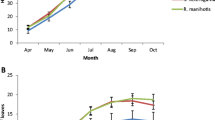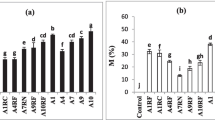Abstract
Three endangered plant species, Plantago atrata and Pulsatilla slavica, which are on the IUCN red list of plants, and Senecio umbrosus, which is extinct in the wild in Poland, were inoculated with soil microorganisms to evaluate their responsiveness to inoculation and to select the most effective microbial consortium for application in conservation projects. Individuals of these taxa were cultivated with (1) native arbuscular mycorrhizal fungi (AMF) isolated from natural habitats of the investigated species, (2) a mixture of AMF strains available in the laboratory, and (3) a combination of AMF lab strains with rhizobacteria. The plants were found to be dependent on AMF for their growth; the mycorrhizal dependency for P. atrata was 91%, S. umbrosus-95%, and P. slavica-65%. The applied inocula did not significantly differ in the stimulation of the growth of P. atrata and S. umbrosus, while in P. slavica, native AMF proved to be the less efficient. We therefore conclude that AMF application can improve the ex situ propagation of these three threatened taxa and may contribute to the success of S. umbrosus reintroduction. A multilevel analysis of chlorophyll a fluorescence transients by the JIP test permitted an in vivo evaluation of plant vitality in terms of biophysical parameters quantifying photosynthetic energy conservation, which was found to be in good agreement with the results concerning physiological parameters. Therefore, the JIP test can be used to evaluate the influence of AMF on endangered plants, with the additional advantage of being applicable in monitoring in a noninvasive way the acclimatization of reintroduced species in nature.




Similar content being viewed by others
References
Barea JM, Gryndler M, Lemanceau P, Schűepp H, Azcón R (2002) The rhizosphere of mycorrhizal plants. In: Gianinazzi S, Schűepp H, Barea JM, Haselwandter K (eds) Mycorrhizal technology in agriculture. From genes to mycorrhiza application. Birkhauser Verlag, Switzerland, pp 1–18
Barea JM, Azcón R, Azcón-Aguilar C (2004) Mycorrhizal fungi and plant growth promoting rhizobacteria. In: Varma A, Abbott D, Werner D, Hampp R (eds) Plant surface microbiology. Springer-Verlag, Berlin, Heidelberg, pp 351–371
Barroetavena C, Gisler SD, Luoma DL, Meinke RJ (1998) Mycorrhizal status of the endangered species Astragalus applegatei Peck as determined from a soil bioassay. Mycorrhiza 8:117–119 doi:10.1007/s005720050222
Bianciotto V, Perotto S, Ruiz-Lozano JM, Bonfante P (2002) Arbuscular mycorrhizal fungi and soil bacteria: from cellular investigations to biotechnological perspectives. In: Gianinazzi S, Schűepp H, Barea JM, Haselwandter K (eds) Mycorrhizal technology in agriculture. From genes to mycorrhiza application. Birkhauser Verlag, Switzerland, pp 19–31
Biró B, Köves-Péchy K, Vörös I, Takács T, Eggenberger P, Strasser RJ (2000) Interactions between Azospirillum and Rhizobium nitrogen-fixers and arbuscular mycorrhizal fungi in the rhizosphere of alfalfa in sterile, AMF-free or normal soil conditions. Appl Soil Ecol 15:159–168 doi:10.1016/S0929-1393(00)00092-5
Biró B, Köves-Péchy K, Tsimilli-Michael M, Strasser RJ (2006) Role of beneficial microsymbionts on the plant performance and plant fitness. In: Mukerji KG, Manoharachary C, Singh J (eds) Microbial activity in the rhizosphere. Soil biology vol. 7 (Varma A-series editor). Springer-Verlag, Berlin, pp 265–296
Enkhtuya B, Rydlová J, Vosátka M (2000) Effectiveness of indigenous and non-indigenous isolates of arbuscular mycorrhizal fungi in soils from degraded ecosystems and man-made habitats. Appl Soil Ecol 14:201–211 doi:10.1016/S0929-1393(00)00057-3
Eriksen M, Bjureke KE, Dhillion SS (2002) Mycorrhizal plants of traditionally managed boreal grasslands in Norway. Mycorrhiza 12:117–123
Fisher JB, Jayachandran K (2002) Arbuscular mycorrhizal fungi enhance seedling growth in two endangered plant species from south Florida. Int J Plant Sci 163(4):559–566 doi:10.1086/340428
Fisher JB, Jayachandran K (2005) Presence of arbuscular mycorrhizal fungi in South Florida native plants. Mycorrhiza 15:580–588 doi:10.1007/s00572-005-0367-0
Fuchs B, Haselwandter K (2004) Red list plants: colonization by arbuscular mycorrhizal fungi and dark septate endophytes. Mycorrhiza 14:277–281 doi:10.1007/s00572-004-0314-5
Gemma JN, Koske RE, Habte M (2002) Mycorrhizal dependency of some endemic and endangered Hawaiian plant species. Am J Bot 89(2):337–345 doi:10.3732/ajb.89.2.337
Helgason T, Merryweather JW, Denison J, Wilson P, Young JPW, Fitter AH (2002) Selectivity and functional diversity in arbuscular mycorrhizas of co-occurring fungi and plants from a temperate deciduous woodland. J Ecol 90:371–384 doi:10.1046/j.1365-2745.2001.00674.x
Hildebrandt U, Janetta K, Bothe H (2002) Towards growth of arbuscular mycorrhizal fungi independent of a host plant. Appl Environ Mirob 68(4):1919–1924 doi:10.1128/AEM.68.4.1919-1924.2002
Hildebrandt U, Ouziad F, Marner FJ, Bothe H (2006) The bacterium Paenibacillus validus stimulates growth of the arbuscular mycorrhizal fungus Glomus intraradices up to the formation of fertile spores. FEMS Microbiol Lett 254:258–267
Johnson TR, Case CL (2004) Laboratory experiments in microbiology, 7th edn. Pearson, Benjamin Cummings, San Francisco, Boston, New York, pp 407–410
Kaźmierczakowa R, Zarzycki K (eds) (2001) Polish red data book of plants (in Polish with English summaries). W. Szafer Institute of Botany, Institute of Nature Conservation, Polish Academy of Sciences, Kraków
McGonile TP, Fitter AH (1990) Ecological specificity of vesicular-arbuscular mycorrhizal associations. Mycol Res 94:120–122
Mirek Z (1991) Senecio umbrosus (Compositae)-a new species in the flora of the Tatra Mountains. Pol Bot Stud 2:213–216
Orłowska E, Ryszka P, Jurkiewicz A, Turnau K (2005) Effectiveness of arbuscular mycorrhizal fungal (AMF) strains in colonization of plants involved in phytostabilisation of zinc wastes. Geoderma 129:92–98 doi:10.1016/j.geoderma.2004.12.036
Panwar J, Vyas A (2002) AM fungi: A biological approach towards conservation of endangered plants in Thar desert, India. Curr Sci India 82(5):576–578
Phillips J, Hayman DS (1970) Improved procedures for clearing roots and staining parasitic and vesicular-arbuscular mycorrhizal fungi for rapid assessment of infection. Trans Br Mycol Soc 55:158–161
Piękoś-Mirkowa H, Kaczmarczyk D (1990) Pulsatilla slavica Reuss-ecology, threat and conservation (in Polish with English summary). Stud Naturae ser A 33:133–166
Piękoś-Mirkowa H, Mirek Z, Miechówka A (1996) Endemic vascular plants in the Polish Tatra Mountains – distribution an ecology. Pol Bot Stud 12:1–107
Pinior A, Grunewaldt-Stöcker G, von Alten H, Strasser RJ (2005) Mycorrhizal impact on drought stress tolerance of rose plants probed by chlorophyll a fluorescence, proline content and visual scoring. Mycorrhiza 15:596–605 doi:10.1007/s00572-005-0001-1
Sastry MSR, Sharma AK, Johri BN (2000) Effect of an AM fungal consortium and Pseudomonas on the growth and nutrient uptake of Eucalyptus hybrid. Mycorrhiza 10:55–61 doi:10.1007/s005720000057
Smith SE, Read DJ (1997) Mycorrhizal symbiosis. Academic, London
Strasser RJ (1978) The grouping model of plant photosynthesis. In: Akoyunoglou G, Argyroudi-Akoyunoglou JH (eds) Chloroplast development. Elsevier/North-Holland Biomedical, Amsterdam, Netherlands, pp 513–524
Strasser RJ (1981) The grouping model of plant photosynthesis: heterogeneity of photosynthetic units in thylakoids. In: Akoyunoglou G (ed) Photosynthesis III. Structure and molecular organization of the photosynthetic apparatus. Balaban. International Science Services, Philadelphia, pp 727–737
Strasser RJ, Srivastava A, Tsimilli-Michael M (2000) The fluorescence transient as a tool to characterize and screen photosynthetic samples. In: Yunus M (ed) Probing photosynthesis: mechanisms, regulation and adaptation. Taylor and Francis, London, pp 445–483
Strasser RJ, Tsimilli-Michael M, Srivastava A (2004) Analysis of the chlorophyll a fluorescence transient. In: Papageorgiou GC, Govindjee (eds) Chlorophyll a fluorescence: a signature of photosynthesis, advances in photosynthesis and respiration series (Govindjee-Series Editor) vol 19. Kluwer Academic, Rotterdam, pp 321–362
Strasser RJ, Tsimilli-Michael M, Dangre D, Rai M (2007) Biophysical phenomics reveals functional building blocks of plants systems biology: a case study for the evaluation of the impact of mycorrhization with Piriformospora indica. In: Varma A, Oelmuller R (eds) Advanced techniques in soil biology. Soil Biology Series, Springer, Germany, pp 220–221
Sylvia DM, Williams SE (1992) Vesicular-arbuscular mycorrhiza and environmental stress. In: Bethlenfalvay GJ, Linderman RG (eds) Mycorrhiza in sustainable agriculture. ASA No 54, Madison, WI, USA, pp 101–124
Sylvia DM, Jarstfer AG, Vosátka M (1993) Comparison of vesicular-arbuscular mycorrhizal species and inocula formulations in a commercial nursery and on diverse Florida beaches. Biol Fertil Soils 16:139–144 doi:10.1007/BF00369416
Trouvelot A, Kough JL, Gianinazzi-Pearson V (1986) Mesure du taux de mycorhization VA d’un systeme radiculaire. Recherche de methodes d’estimation ayant une signification fonctionnelle. In: Gianinazzi-Pearson V, Gianinazzi S (eds) Physiological and genetical aspects of mycorrhizae. INRA, Paris, pp 217–221 http://www.dijon.inra.fr/bbceipm/Mychintec/Mycocalc-prg/download.html
Tsimilli-Michael M, Eggenberg P, Biró B, Köves-Pechy K, Vörös I, Strasser RJ (2000) Synergistic and antagonistic effects of arbuscular mycorrhizal fungi and Azospirillum and Rhizobium nitrogen-fixers on the photosynthetic activity of alfalfa, probed by the polyphasic chlorophyll a fluorescence transient O-J-I-P. Appl Soil Ecol 15:169–182 doi:10.1016/S0929-1393(00)00093-7
Tsimilli-Michael M, Strasser RJ (2008) In vivo assessment of plants’ vitality: applications in detecting and evaluating the impact of mycorrhization on host plants. In: Varma A (ed) Mycorrhiza: state of the art, genetics and molecular biology, eco-function, biotechnology, eco-physiology, structure and systematics (3rd edn). Springer, pp 679–703
Turnau K, Haselwandter K (2002) Arbuscular mycorrhizal fungi, an essential component of soil microflora in ecosystem restoration. In: Gianinazzi S, Schűepp H, Barea JM, Haselwandter K (eds) Mycorrhizal technology in agriculture. From genes to mycorrhiza application. Birkhauser Verlag, Switzerland, pp 137–149
Van Aarle JM, Olsson PA, Soderstrom B (2001) Microscopic detection of phosphatase activity of saprophytic and arbuscular mycorrhizal fungi using a fluorogenic substrate. Mycologia 93:17–24 doi:10.2307/3761601
Van der Heijden MGA (2002) Arbuscular mycorrhizal fungi as determinant of plant diversity: in search for underlying mechanisms and general principles. In: Van der Heijden MGA, Sanders IR (eds) Mycorrhizal ecology. Springer, Berlin, pp 243–266
Vivas A, Marulanda A, Ruiz-Lozano JM, Barea JM, Azcón R (2003) Influence of Bacillus sp. on physiological activities of two arbuscular mycorrhizal fungi and on plant response to PEG-induces drought stress. Mycorrhiza 13:249–256 doi:10.1007/s00572-003-0223-z
Vosátka M (1995) Influence of inoculation with arbuscular mycorrhizal fungi on the growth and mycorrhizal infection of transplanted onion. Agric Ecosyst Environ 53:151–159 doi:10.1016/0167-8809(94)00563-T
Vosátka M, Gryndler M (2000) Response of micropropagated potatoes transplanted to peat media to post-vitro inoculation with arbuscular-mycorrhizal fungi and soil bacteria. Appl Soil Ecol 15:145–152 doi:10.1016/S0929-1393(00)00090-1
Vosátka M, Dodd JC (2002) Ecological considerations for successful application of arbuscular mycorrhizal fungi inoculum. In: Gianinazzi S, Schűepp H, Barea JM, Haselwandter K (eds) Mycorrhizal technology in agriculture. From genes to mycorrhiza application. Birkhauser Verlag, Switzerland, pp 235–247
Zaady E, Okon Y, Perevolotsky A (1994) Growth response of Mediterranean herbaceous swards to inoculation with Azospirillum brasilense. J Range Manage 47(1):12–15 doi:10.2307/4002833
Zubek S, Turnau K, Błaszkowski J (2005) Arbuscular mycorrhiza of plants from the Mountain Botanical Garden in Zakopane. Acta Mycol 40(1):25–41
Zubek S, Turnau K, Błaszkowski J (2008) Arbuscular mycorrhiza of endemic and endangered plants from the Tatra Mts. Acta Soc Bot Pol 77(2):149–156
Acknowledgements
The present research was financially supported by the Polish Ministry of Science and Higher Education, Project No. 2 P04G 00628 (2005–2006), and the Jagiellonian University funds DS/758/UJ. Support by the Swiss National Science Foundation, Project Nr: 200021-116765, to M.T.-M. and R.J.S. is acknowledged. The authors thank Prof. H. Bothe and Dr. U. Hildebrandt (Institute of Botany, University of Cologne) for providing us with the bacterial strains. Prof. H. Piękoś-Mirkowa, M. Pacyna, M.Sc. Eng. A. Delimat, and M.Sc. Eng. E. Walusiak (Institute of Nature Conservation of the Polish Academy of Sciences, Kraków) are acknowledged for providing us with the seeds of threatened taxa and for their useful remarks concerning plant cultivation. We are also grateful to the authorities of the Tatra National Park (TPN) for the permission for soil samples collection.
Author information
Authors and Affiliations
Corresponding author
Rights and permissions
About this article
Cite this article
Zubek, S., Turnau, K., Tsimilli-Michael, M. et al. Response of endangered plant species to inoculation with arbuscular mycorrhizal fungi and soil bacteria. Mycorrhiza 19, 113–123 (2009). https://doi.org/10.1007/s00572-008-0209-y
Received:
Accepted:
Published:
Issue Date:
DOI: https://doi.org/10.1007/s00572-008-0209-y




